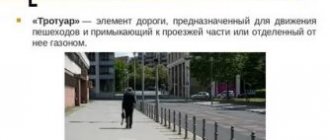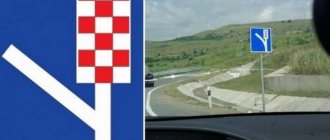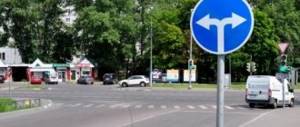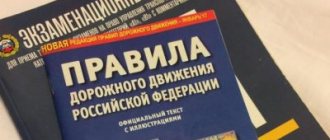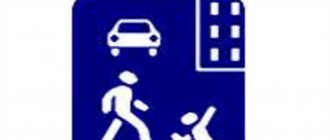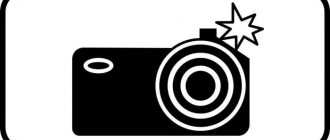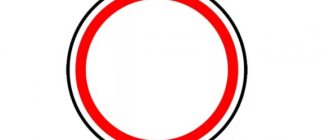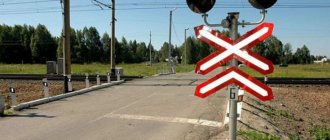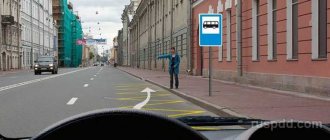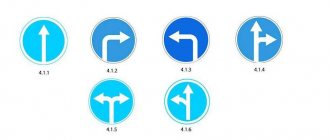Slide captions:
Signs for pedestrians and drivers Life safety teacher, Alexey Alexandrovich Beresnev
Why are road signs needed? Road signs perform the same service as traffic lights, street and road marking lines. They regulate the flow of cars and people, make the work of drivers easier, and help pedestrians navigate correctly in difficult traffic conditions.
Where and how are road signs installed? The signs are located along the entire road route so that they are always to the right of the driver, so that he can see them without turning his head. Signs are mounted on special racks, on poles or suspended above the roadway.
ROAD SIGN - a sign with a schematic drawing installed near the road to communicate certain information to road users.
Practical task Draw signs in a notebook. Sign which group they belong to and who needs them: a pedestrian or a driver? Sign 1.22 “Pedestrian crossing” is located in cities 50-100 m before signs 5.19.1 – 5.19.2. Warns the driver that a pedestrian crossing is approaching, he must slow down and be extremely careful. Warning
The practical task is installed to the right of the road at the near border of the crossing relative to approaching vehicles, and sign 5.19.2 is installed to the left of the road at the far border of the crossing. Special requirements
Practical task 1.23 “Children”. The section of road nearby is located in the area of schools, kindergartens, and clubs. It warns the driver about the possibility of children appearing in this place on the road, but does not mean at all that it is possible to cross the road here. Warning
Practical task 3.10 “Pedestrian traffic is prohibited.” prohibiting
Practical task prescriptive 4.5 “Pedestrian path”. Only pedestrians are allowed to move.
Practical task Information
Practical task 3.9 “Bicycles are prohibited.” Bicycles and mopeds are prohibited. prohibiting
Practical task prescriptive 4.4 “Bicycle path”. Only bicycles and mopeds are allowed. Pedestrians can also use the bike path (if there is no sidewalk or pedestrian path).
EXERCISE. Find mistakes in pedestrian behavior...
Thank you for your attention
Preview:
Lesson 5. Signs for pedestrians and drivers.
Purpose of the lesson: teach how to use signs for pedestrians and drivers; consolidate these skills in practice.
Equipment: traffic regulations brochure, street layout with pedestrian path signs, enlarged signs 1.22, 1.23, 3.9, 3.10, 4.6, 4.6, 5.19.1 – 5.19.2, 5.17.1 – 5.17.2, 5.17.3 – 5.17.4; cards with signs of different groups for the game “Road Sign Experts”.
Recommendations for conducting a lesson.
The teacher begins the lesson with a conversation repeating the material covered.
Why are road signs needed? Road signs perform the same service as traffic lights, street and road marking lines. They regulate the flow of cars and people, make the work of drivers easier, and help pedestrians navigate correctly in difficult traffic conditions.
Where and how are road signs installed? The signs are located along the entire road route so that they are always to the right of the driver, so that he can see them without turning his head. Signs are mounted on special racks, on poles or suspended above the roadway.
What groups are all road signs divided into? Warning, prohibiting, prescriptive, priority, informational and indicative, service, additional information. There are 7 groups in total.
To better consolidate knowledge, it is recommended to use different versions of the game “Connoisseurs of Road Signs” (material from lesson 4 in 5th grade).
Stage 1 . Draw the signs 1.22, 1.23, 5.19.1 – 5.19.2 in your notebook; 3.10 and 4.6. Sign which group they belong to and who needs them: a pedestrian or a driver?
All signs have little people drawn in the center. But they differ in color and shape. Which of these are signs for drivers, and which for pedestrians?
These signs are from the warning group. They are both identical, triangular in shape with a red border. These are signs for drivers.
Sign 1.22 “Pedestrian crossing” is located in cities 50-100 m before signs 5.19.1 – 5.19.2 (note that these signs have the same names, but have different meanings). Sign 1.22 warns the driver that a pedestrian crossing is approaching, he must slow down and be extremely careful.
Sign 1.23 “Children” is located in the area of schools, kindergartens, and clubs. It warns the driver about the possibility of children appearing in this place on the road, but does not mean at all that it is possible to cross the road here.
Signs 3.10 and 4.6 for pedestrians. Both of them are round and there are little men in the center, but the color of the signs is different and they belong to different groups. The sign with a red border, where the man is crossed out, refers to prohibitory signs - 3.10 “Pedestrian movement is prohibited.” The sign with the little man on a blue background belongs to the group of prescriptive signs - this is where you can walk: 4.6 - “Pedestrian path”.
And another group of signs with people. They are all square with a blue background. These are informational signs for pedestrians, that is, they indicate where you can cross the road (see appendix, figure 37 and 38).
6.6. "Underground pedestrian crossing."
6.7 “Overground pedestrian crossing.”
There are also signs with the same design in the center, but with different meanings. For example, signs 3.9 and 4.4 with a bicycle in the center for cyclists, both have a circular shape. But sign 3.9 with a red border, where a bicycle is on a white background, means “Roading on bicycles is prohibited” and belongs to the group of prohibitory signs.
Sign 4.6 “Bicycle path”, where a bicycle is on a blue background, just means that you can ride bicycles here. This sign belongs to the prescriptive group.
Stage 2. Solving problems using a model of a residential neighborhood with a road.
Source: nsportal.ru
Definition according to traffic rules
A pedestrian path is a strip of land or artificial surface that is adapted and equipped for pedestrian traffic.
The pedestrian path is marked with a mandatory sign 4.5.1. This sign is easy to recognize: a white silhouette of a walking person is depicted in a blue circle with a white border. You can see this designation in large cities, since the sign is used infrequently and only in areas where it is needed. The pedestrian path can be made of any solid material, not necessarily asphalt.
ATTENTION! A pedestrian path and a sidewalk are two different things. Their difference is that the sidewalk is part of the road (it is only separated from it), while the pedestrian path is not. In addition, it can be located not only near the roadway, but also in a park, for example. The sidewalk and walkway may be located next to each other, but the sidewalk does not have special signs. At the same time, a pedestrian path can be a sidewalk if it is separated from the roadway by a lawn, green spaces or engineering structures, and is marked with sign 4.5.1.
What does the sign mean
Sign 4.5.1 within its coverage area allows the movement of pedestrians and cyclists (but only in the absence of a bicycle path and the impossibility of riding on the side of the road). Motorists are strictly prohibited from entering the pedestrian path, including parking on it. Only pedestrians and categories of citizens equivalent to them (children on sleds, wheelchair users and others) may be in the area of effect of sign 4.5.1.
On a footpath, people have the right to walk peacefully at the speed at which they feel comfortable. They are not obliged to rush somewhere, give way to cyclists, etc. This is a safe area intended for walking.
What are the features of the pointer?
The sign extends to the nearest intersection with the roadway or to sign 4.5.3 “End of a pedestrian and bicycle path with combined traffic (end of a bicycle and pedestrian path with combined traffic).” In reality, a sign announcing the end is rarely installed, so you need to look at the intersections.
Sign 4.5.3 is installed if the pedestrian path is combined with a bicycle path, that is, indicated by the sign 4.5.2, and not 4.5.1. There is no separate “pair” for 4.5.1.
The sign is placed at the beginning of the path to the right of it. As soon as an intersection with a road is encountered, the sign must be repeated. This is how the entire length of the path should be designated.
The sign can be covered with a reflective element so that it is visible in the dark and in bad weather. The diameter of the pointer is 70 cm.
IMPORTANT! A pedestrian path and a pedestrian crossing are not identical concepts. The crossing is intended for pedestrian traffic across the roadway, therefore, unlike the path, it is part of the road and has a special marking (“zebra crossing”). It has different rules and requirements for both drivers and pedestrians. The signs belong to different categories and differ significantly: it is worth remembering at least that the sign at the crossing has a square shape, in contrast to the round one 4.5.1.
What is the difference from the pedestrian zone
The pedestrian zone is indicated by sign 5.33, which belongs to the category of signs of special instructions (while 4.5.1 - to prescriptive ones). A pedestrian zone is an urban area intended exclusively for pedestrian traffic.
It is prohibited to travel on motor vehicles, with the exception of vehicles of special services, public utilities, public transport and vehicles serving shops. The end of this zone is indicated by sign 5.34.
Pedestrian zones can be a measure to free popular streets (tourist streets, for example) from traffic. This is done not only for safety, but also to improve the environment and preserve the culturally significant features of a particular city.
A pedestrian path differs from a pedestrian zone in several ways:
- It is one road for walking. A pedestrian area may have many paths, squares and various elements intended for pedestrians.
- The zone occupies a larger area than the track. It may also include a sidewalk with curbs.
- Intersections do not affect the operation of sign 5.33. The pedestrian zone extends to the point where sign 5.34 is installed.
Externally, the “Pedestrian zone” sign is different in that this blue circle with a white silhouette of a person is depicted inside a white shield, which also has a red asterisk (*) below and “zone” written on top. The sign may be combined with additional circumstances determined by plates 8.5. In this case, the pedestrian zone operates at a certain time of day, day of the week or month.
IMPORTANT! Pedestrian paths and zones are independent parts and not components of the road. Both of these signs are installed to ensure safe travel on foot. Since in small cities pedestrians do not have problems with places to walk, and the traffic intensity is not as high as in megacities, the installation of these signs is an infrequent occurrence. However, the zone may be specially designated near residential buildings, schools, kindergartens, etc. in order to prevent vehicles from entering crowded areas.
Traffic signs that help pedestrians
Traffic rules should be learned not only by motorists, but also by those who are used to traveling on foot. Ignorance of the rules can lead to dire consequences. Here are 10 traffic signs that help pedestrians stay safe.
Indicates an area for safe crossing of the road and obliges motorists to slow down to let a pedestrian pass.
Shows particularly dangerous road sections where pedestrian traffic is prohibited.
The sign is installed at a suspension bridge that allows you to safely cross a busy highway or railroad tracks.
Entrance to a tunnel intended for crossing the road underground.
Symbolizes a section of the road on which only pedestrians and cyclists are allowed to travel.
Indicates an area designated for pedestrian use only. Vehicles are not allowed to enter.
“End of the pedestrian zone” symbolizes the end of an area intended only for walking.
The sign indicates an area where people can drive across the full width of the roadway, but caution must still be exercised. The maximum vehicle speed in a residential area is 20 km/h.
“End of the residential area” symbolizes the end of the safe area.
Inform passers-by about the location of the landing site or place to stop public transport.
Pedestrians are the same road users as drivers, so even a child should know the meaning of signs. The rules will help avoid chaos on the roads and innocent victims.
Source: autozam.ru
Sign requirements
The main requirement of the road sign in question is to restrict foot traffic.
It is usually used in the following places:
- on bridges and in tunnels - vehicles are prohibited from stopping here, so pedestrians have nothing to do here;
- on highways or highways - in such places the speed of cars is high, so the driver may not notice a person walking;
- in areas where road repairs are being carried out - equipment is working in such areas and the presence of strangers is dangerous.
“Pedestrian traffic prohibited” also applies in other situations. However, these are the ones that are most common.
Presentation on traffic rules “Road signs for pedestrians” (grade 1)
How to organize distance learning during quarantine?
The Infourok project helps
Description of the presentation by individual slides:
The presentation was prepared by a primary school teacher at Municipal Budget Educational Institution Gymnasium No. 2 of Salsk, Rotov Region, Elena Yurievna Zimbalist Road signs for pedestrians Lesson on extracurricular activities “The ABCs of Traffic” 1st grade
teach children to distinguish road signs by color and shape; to form a system of knowledge about road signs and traffic rules; develop cognitive interests, logical thinking, memory, observation skills; cultivate discipline and organization; to form a culture of behavior on the street and road; increase the level of speech development.
There is a land crossing here, people walk all day long. You, driver, don’t be sad, let the pedestrian pass!
“Underground pedestrian crossing” Every pedestrian knows about this underground passage. It doesn't decorate the city, But it doesn't interfere with cars!
“Pedestrian traffic is prohibited” No pedestrians walk here in rain or shine. The sign tells them one thing: “You are prohibited from walking!”
“PEDESTRIAN PATH” Only feet walk along the pedestrian path. Only in a stroller and in the cinema is it possible to travel around.
“Public transport stopping place” At this place, a pedestrian waits patiently for transport. He's tired of walking, he wants to become a passenger.
Bicycle path Overtake Maxim Seryozhka. No one will bother you - All children know this sign. "BIKE LANE"
“TRAFFIC ON BICYCLES IS PROHIBITED” On my birthday I was given a high-speed bicycle. They taught me and explained how to ride where there is no sign.
Watching the cartoon Lessons from Aunt Owl “The ABCs of Road Safety”
Test "Test yourself!"
Name a sign that prohibits pedestrian traffic. A B C
What does this road sign mean? stairs to the basement underground passage above ground passage
Find the sign “Tram stop” A B C
What sign is called "Pedestrian path"? A B C D
Which sign indicates the safest road crossing? A B C
Which sign indicates "Bike path"? A B
Work in a notebook.
Free distance competition “Stop Coronavirus”
- Tsimbalist Elena YurievnaWrite 9643 03/27/2016
Material number: DV-559718
Add original materials and receive prizes from Infourok
Weekly prize fund 100,000 RUR
- 27.03.2016 1279
- 27.03.2016 1107
- 27.03.2016 31049
- 27.03.2016 1680
- 27.03.2016 6839
- 27.03.2016 546
- 27.03.2016 1426
Didn't find what you were looking for?
You might be interested in these courses:
All materials posted on the site were created by the authors of the site or posted by users of the site and are presented on the site for informational purposes only. Copyrights for materials belong to their legal authors. Partial or complete copying of site materials without written permission from the site administration is prohibited! Editorial opinion may be different from those of the authors.
Responsibility for resolving any controversial issues regarding the materials themselves and their contents is taken by the users who posted the material on the site. However, the site’s editors are ready to provide all possible support in resolving any issues related to the work and content of the site. If you notice that materials are being used illegally on this site, please notify the site administration using the feedback form.
Source: infourok.ru
The difference between a pedestrian zone and a pedestrian path
These two concepts are often confused due to their similarities. There are such differences:
- a path is a small area designated for crossing. The zone is much larger, it includes sections of the road, curbs, sidewalks;
- The path is marked only at the beginning and up to the point of the first intersection. A separate sign indicates its end;
- Often people walk near shops, crossing areas used by their owners to unload goods. In this case, permission to move vehicles along pedestrian paths remains possible. At the same time, cars are prohibited from entering pedestrian areas.
To avoid administrative liability, drivers must remember the rules and carefully monitor every road sign.
Road signs for pedestrians
In the Russian Federation, there are currently more and more cars every year. At the same time, it is becoming increasingly difficult for pedestrians to move around the city, since careless motorists often do not seek to use their knowledge of road signs.
According to the Road Traffic Rules, as amended and supplemented, a pedestrian is a full participant in traffic, which means he is simply obliged to follow the rules of conduct on the road. Knowing road signs can save your health and sometimes your life.
These small images, constantly flashing on the roads, should become not empty space for the pedestrian, but faithful assistants on the way. Their thorough knowledge, of course, will help you feel more confident on the road and not get into ridiculous situations.
Road signs for pedestrians are contained in a separate section of the Rules of the Road. In the pictures that are in it, you can find the necessary road signs. All pictures of road signs are provided with explanations that are understandable in “human” language. They are very easy to remember and help you later navigate in any, even the most critical traffic situation.
One of the main signs that every pedestrian of any age should know is the pedestrian crossing sign. This sign informs you that it is possible to cross the roadway next to it. It is located near a special marking, popularly called a “zebra”. This square sign is only for pedestrians, but the triangular shape of the same road sign is intended only for motorists.
The next sign, relevant for pedestrians of any age, will be the “Underground passage”. It is installed at the entrance to the underground pedestrian crossing. You should not cross the roadway if this road sign is nearby.
It is quite useful to learn the signs indicating where the bus or tram stops. Please note that these signs are installed as close as possible to the waiting area for vehicles. If you have children, be sure to tell them about the rules of conduct while waiting for a bus or tram. This same sign is important for the driver, since his attention becomes more intense when approaching a stop with people.
For every pedestrian, and especially those living in a metropolis, the “Pedestrian path” and “Bicycle path” road signs will be useful. It is worth explaining to children that the pedestrian path is intended exclusively for pedestrians, but the bicycle path can be used by cyclists and moped drivers, but pedestrians can also walk on it. On these paths you need to walk on the right side, and you certainly shouldn’t interfere with other road users.
There are a number of prohibitory signs in the Road Traffic Rules for each pedestrian. A “No Entry” sign or simply a brick means that pedestrians will have priority in traffic. Remember that if you are riding a bicycle, then there is no path under the sign, but if you drive it in your hands, then the path will be clear.
Another sign that is important for pedestrians will be a sign that prohibits pedestrian traffic.
Knowing road signs and traffic rules for pedestrians will help you feel more confident on the road and not create emergency situations.
Add a comment Cancel reply
You must be logged in to post a comment.
Source: pdd-baza.ru
Varieties of sign
The traffic rules also provide for other signs that are similar to the “Pedestrian path” sign both externally and in scope. These signs indicate the possibility of combined traffic for pedestrians and cyclists.
Let's list them:
- Sign 4.5.2. - intended for movement of both pedestrians and cyclists;
- Signs 4.5.4 and 4.5.5 - are intended for the movement of pedestrians and cyclists with division into lanes. Here, each traffic participant moves along his own dedicated lane.
Sign 4.5.2 - “Pedestrian and bicycle path with combined traffic”
